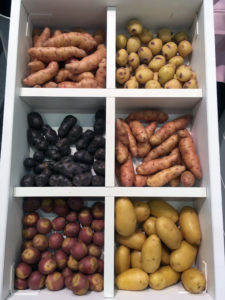Jun 28, 2018Three keys to storing specialty potatoes
Over the past decade or so, consumer demand for potatoes has changed, leaning toward smaller, specialty varieties. This change has meant that growers have had to relearn storage techniques, as the smaller varieties don’t store in bulk as well as America’s favorite potato, the russet.
Contributor Melanie Epp broke down the storage considerations growers need to think through when meeting the demand for specialty potatoes for the July/August issue of Spudman.
Here are a few takeaways.

1 Surface to weight ratio makes bins more attractive
What makes storing specialty potatoes different is that their surface-to-weight ratio is larger, which means they require more space for ventilation. The skin has a higher permeability, he said, so water can more easily escape. Storing them in traditional bulk stores increases losses to pressure bruise.
“When you get into these thin-skinned, high-surface area weight-to-ratio potatoes, you have to change gears,” said Todd Forbush, postharvest potato storage expert with Techmark in Lansing, Michigan.
2 Switching to bins comes with challenges, but is doable
Dim Jan de Visser, commercial director for Tolsma-Grisnich, a Dutch company that specializes in storage technology, said one of the reasons he thinks U.S. growers don’t move to bins is because of the opinion they’re too expensive. This, he says, is because they were being shipped from Europe at double the price.
Today, there are bins coming from Europe at half the price, especially from Poland. De Visser recommended InterAgra, a Polish company that he says makes, reliable, high quality bins capable of holding 3,000 lbs for an attractive price. Bins of the same quality cost twice as much in the U.S., he said, mostly because the factories do not have the capacity to make them at the rate they can in Europe. The U.S., he said, relies on more manual labor. “It costs them too much money,” he said.
De Visser said U.S. packers will need better filling systems in order to keep up with the higher volumes. Tolsma-Grisnich builds high-capacity filling systems, and there are other European dealerships offering solutions that are capable of filling up to 150 bins an hour.
3 Bin material is up to you
In terms of bins, Forbush said there are as many growers who prefer plastic over wood as there are who prefer wood over plastic. Plastic bins are more expensive, but wood has higher maintenance and cleaning costs. Wood will absorb some moisture, which is good when potatoes come in wet, but not when they’re dry.
“We’ve got very good customers who use both,” Forbush said.
Troy Craig, Tolsma-Grisnich area sales manager for Idaho, recommends wood. “You can’t fit as many potatoes in plastic,” he said, pointing out that silver scurf is an issue in plastic more so than it is in wood. While some worry about disease staying in wood, Craig says wooden bins can easily be washed and disinfected.
For the full story read the July/August Spudman.
By Melanie Epp, Contributing Writer














